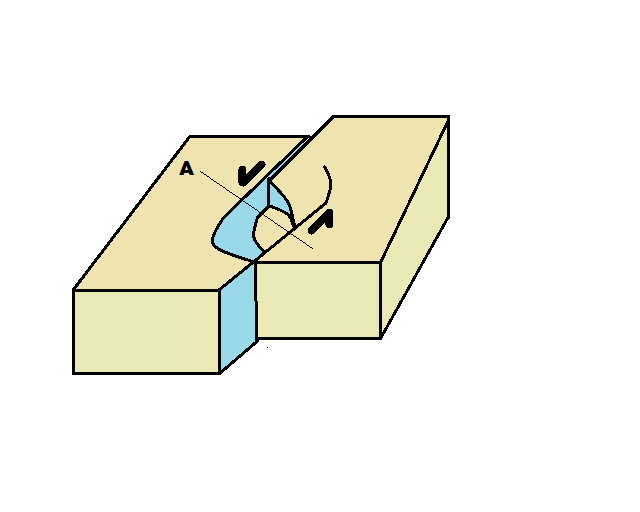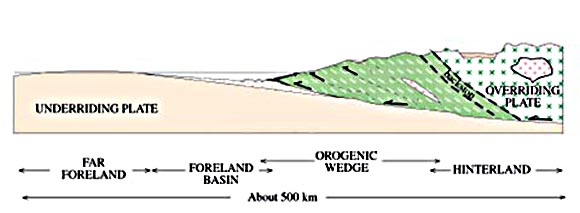tectonic subsidence on:
[Wikipedia]
[Google]
[Amazon]
Tectonic subsidence is the
 Where the lithosphere undergoes horizontal extension at a normal fault or rifting center, the crust will stretch until faulting occurs, either by a system of
Where the lithosphere undergoes horizontal extension at a normal fault or rifting center, the crust will stretch until faulting occurs, either by a system of
 Lithospheric stretching/thinning during rifting results in regional necking of the lithosphere (the elevation of the upper surface decreases while the lower boundary rises). The underlying asthenosphere passively rises to replace the thinned mantle lithosphere. Subsequently, after the rifting/stretching period ends, this shallow asthenosphere gradually cools back into mantle lithosphere over a period of many tens of millions of years. Because mantle lithosphere is denser than asthenospheric mantle, this cooling causes subsidence. This gradual subsidence due to cooling is known as "thermal subsidence".
Lithospheric stretching/thinning during rifting results in regional necking of the lithosphere (the elevation of the upper surface decreases while the lower boundary rises). The underlying asthenosphere passively rises to replace the thinned mantle lithosphere. Subsequently, after the rifting/stretching period ends, this shallow asthenosphere gradually cools back into mantle lithosphere over a period of many tens of millions of years. Because mantle lithosphere is denser than asthenospheric mantle, this cooling causes subsidence. This gradual subsidence due to cooling is known as "thermal subsidence".


 Intracontinental basins are large areal depressions that are tectonically inactive and not near any plate boundaries. Multiple hypotheses have been introduced to explain this slow, long-lived subsidence: long-term cooling since the breakup of Pangea, interaction of deformation around the edge of the basin and deep earth dynamics. The Illinois basin and Michigan basin are examples of intracontinental basins. Extensive swamps are sometimes formed along the shorelines of these basins, leading to the burial of plant matter that later forms coal.
Intracontinental basins are large areal depressions that are tectonically inactive and not near any plate boundaries. Multiple hypotheses have been introduced to explain this slow, long-lived subsidence: long-term cooling since the breakup of Pangea, interaction of deformation around the edge of the basin and deep earth dynamics. The Illinois basin and Michigan basin are examples of intracontinental basins. Extensive swamps are sometimes formed along the shorelines of these basins, leading to the burial of plant matter that later forms coal.

 Foreland basins are flexural depressions created by large fold thrust sheets that form toward the undeformed continental crust. They form as an isostatic response to an orogenic load. Basin growth is controlled by load migration and corresponding sedimentation rates. The broader a basin is, the greater the subsidence is in magnitude. Subsidence is increased in the adjacent basin as the load migrates further into the foreland, causing subsidence. Sediment eroded from the fold thrust is deposited in the basin, with thickening layers toward the thrust belt and thinning layers away from the thrust belt; this feature is called differential subsidence.
Foreland basins are flexural depressions created by large fold thrust sheets that form toward the undeformed continental crust. They form as an isostatic response to an orogenic load. Basin growth is controlled by load migration and corresponding sedimentation rates. The broader a basin is, the greater the subsidence is in magnitude. Subsidence is increased in the adjacent basin as the load migrates further into the foreland, causing subsidence. Sediment eroded from the fold thrust is deposited in the basin, with thickening layers toward the thrust belt and thinning layers away from the thrust belt; this feature is called differential subsidence.
sinking
Sinking may refer to:
* Sinking of a ship; see shipwrecking
* Being submerged
* ''Sinking'' (album), a 1996 studio album by The Aloof
* Sinking (behavior), the act of pouring out champagne in the sink
* Sinking (metalworking), a metalworking t ...
of the Earth's crust on a large scale, relative to crustal-scale features or the geoid. The movement of crustal plates and accommodation spaces created by faulting create subsidence on a large scale in a variety of environments, including passive margins, aulacogens, fore-arc basins, foreland basins, intercontinental basins and pull-apart basin
In geology, a basin is a region where subsidence generates accommodation space for the deposition of sediments. A pull-apart basin is a structural basin where two overlapping (en echelon) strike-slip faults or a fault bend creates an area of cru ...
s. Three mechanisms are common in the tectonic environments in which subsidence occurs: extension, cooling and loading.
Mechanisms
Extension
normal faults Normal(s) or The Normal(s) may refer to:
Film and television
* Normal (2003 film), ''Normal'' (2003 film), starring Jessica Lange and Tom Wilkinson
* Normal (2007 film), ''Normal'' (2007 film), starring Carrie-Anne Moss, Kevin Zegers, Callum Keit ...
(which creates horsts and grabens) or by a system of listric faults. These fault systems allow the region to stretch, while also decreasing its thickness. A thinner crust subsides relative to thicker, undeformed crust.
Cooling
 Lithospheric stretching/thinning during rifting results in regional necking of the lithosphere (the elevation of the upper surface decreases while the lower boundary rises). The underlying asthenosphere passively rises to replace the thinned mantle lithosphere. Subsequently, after the rifting/stretching period ends, this shallow asthenosphere gradually cools back into mantle lithosphere over a period of many tens of millions of years. Because mantle lithosphere is denser than asthenospheric mantle, this cooling causes subsidence. This gradual subsidence due to cooling is known as "thermal subsidence".
Lithospheric stretching/thinning during rifting results in regional necking of the lithosphere (the elevation of the upper surface decreases while the lower boundary rises). The underlying asthenosphere passively rises to replace the thinned mantle lithosphere. Subsequently, after the rifting/stretching period ends, this shallow asthenosphere gradually cools back into mantle lithosphere over a period of many tens of millions of years. Because mantle lithosphere is denser than asthenospheric mantle, this cooling causes subsidence. This gradual subsidence due to cooling is known as "thermal subsidence".
Loading
The adding of weight by sedimentation fromerosion
Erosion is the action of surface processes (such as water flow or wind) that removes soil, rock, or dissolved material from one location on the Earth's crust, and then transports it to another location where it is deposited. Erosion is di ...
or orogenic processes, or loading, causes crustal depression and subsidence. Sediments accumulate at the lowest elevation possible, in accommodation spaces. The rate and magnitude of sedimentation controls the rate at which subsidence occurs. By contrast, in orogenic processes, mountain building creates a large load on the Earth's crust, causing flexural depressions in adjacent lithospheric crust.
Subduction erosion
Environments
Tectonically inactive
These settings are not tectonically active, but still experience large-scale subsidence because of tectonic features of the crust.Intracontinental basins


 Intracontinental basins are large areal depressions that are tectonically inactive and not near any plate boundaries. Multiple hypotheses have been introduced to explain this slow, long-lived subsidence: long-term cooling since the breakup of Pangea, interaction of deformation around the edge of the basin and deep earth dynamics. The Illinois basin and Michigan basin are examples of intracontinental basins. Extensive swamps are sometimes formed along the shorelines of these basins, leading to the burial of plant matter that later forms coal.
Intracontinental basins are large areal depressions that are tectonically inactive and not near any plate boundaries. Multiple hypotheses have been introduced to explain this slow, long-lived subsidence: long-term cooling since the breakup of Pangea, interaction of deformation around the edge of the basin and deep earth dynamics. The Illinois basin and Michigan basin are examples of intracontinental basins. Extensive swamps are sometimes formed along the shorelines of these basins, leading to the burial of plant matter that later forms coal.
Extensional
Tectonic subsidence can occur in these environments as the crust thinning.Passive margins
Successful rifting creates a spreading center like a mid-ocean ridge, which moves progressively further from coastlines as oceanic lithosphere is produced. Due to this initial phase of rifting, the crust in a passive margin is thinner than adjacent crust and subsides to create an accommodation space. Accumulation of non-marine sediment forms alluvial fans in the accommodation space. As rifting proceeds, listric fault systems form and further subsidence occurs, resulting in the creation of an ocean basin. After the cessation of rifting, cooling causes the crust to further subside, and loading with sediment will cause further tectonic subsidence.Aulacogens
Aulacogens occur at failed rifts, where continental crust does not completely split. Similar to the lithospheric heating that occurs during the formation of passive margins, subsidence occurs due to heated lithosphere sagging as spreading occurs. Once tensional forces cease, subsidence continues due to cooling.Collisional
Tectonic subsidence can occur in these settings as the plates collide against or under each other.Pull-apart basins
Pull-apart basin
In geology, a basin is a region where subsidence generates accommodation space for the deposition of sediments. A pull-apart basin is a structural basin where two overlapping (en echelon) strike-slip faults or a fault bend creates an area of cru ...
s have short-lived subsidence that forms from transtensional strike-slip faults. Moderate strike-slip faults create extensional releasing bends and opposing walls pull apart from each other. Normal faults occur, inducing small scale subsidence in the area, which ceases once the fault stops propagating. Cooling occurs after the fault fails to propagate further following the crustal thinning via normal faulting. Lee, E.Y. and Wagreich, M., 2017: "Polyphase tectonic subsidence evolution of the Vienna Basin inferred from quantitative subsidence analysis of the northern and central parts" International Journal of Earth Sciences 106, 687-705, https://link.springer.com/article/10.1007/s00531-016-1329-9
Forearc basins
Forearc basins
Forearc is a plate tectonic term referring to a region between an oceanic trench, also known as a subduction zone, and the associated volcanic arc. Forearc regions are present along a convergent margins and eponymously form 'in front of' the vol ...
form in subduction zones as sedimentary material is scraped off the subducting oceanic plate, forming an accretionary prism between the subducting oceanic lithosphere and the overriding continental plate. Between this wedge and the associated volcanic arc is a zone of depression in the sea floor. Extensional faulting due to relative motion between the accretionary prism and the volcanic arc may occur. Abnormal cooling effects due to the cold, water-laden downgoing plate as well as crustal thinning due to underplating may also be at work.
Foreland basins
 Foreland basins are flexural depressions created by large fold thrust sheets that form toward the undeformed continental crust. They form as an isostatic response to an orogenic load. Basin growth is controlled by load migration and corresponding sedimentation rates. The broader a basin is, the greater the subsidence is in magnitude. Subsidence is increased in the adjacent basin as the load migrates further into the foreland, causing subsidence. Sediment eroded from the fold thrust is deposited in the basin, with thickening layers toward the thrust belt and thinning layers away from the thrust belt; this feature is called differential subsidence.
Foreland basins are flexural depressions created by large fold thrust sheets that form toward the undeformed continental crust. They form as an isostatic response to an orogenic load. Basin growth is controlled by load migration and corresponding sedimentation rates. The broader a basin is, the greater the subsidence is in magnitude. Subsidence is increased in the adjacent basin as the load migrates further into the foreland, causing subsidence. Sediment eroded from the fold thrust is deposited in the basin, with thickening layers toward the thrust belt and thinning layers away from the thrust belt; this feature is called differential subsidence.
References
{{Reflist Plate tectonics